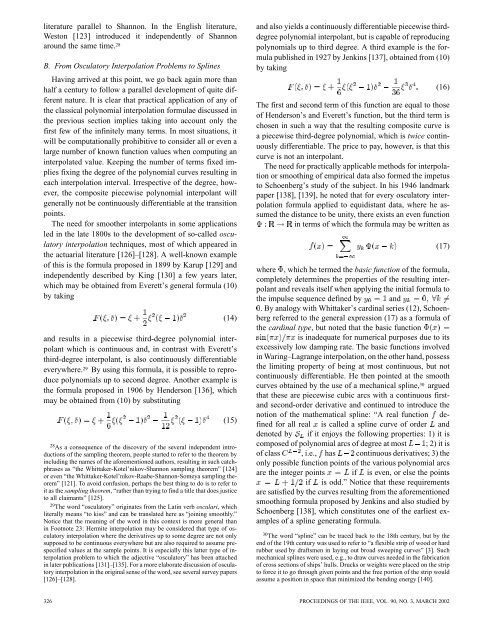from ancient astronomy to modern signal and image processing
from ancient astronomy to modern signal and image processing
from ancient astronomy to modern signal and image processing
You also want an ePaper? Increase the reach of your titles
YUMPU automatically turns print PDFs into web optimized ePapers that Google loves.
literature parallel <strong>to</strong> Shannon. In the English literature,Wes<strong>to</strong>n [123] introduced it independently of Shannonaround the same time. 28B. From Oscula<strong>to</strong>ry Interpolation Problems <strong>to</strong> SplinesHaving arrived at this point, we go back again more thanhalf a century <strong>to</strong> follow a parallel development of quite differentnature. It is clear that practical application of any ofthe classical polynomial interpolation formulae discussed inthe previous section implies taking in<strong>to</strong> account only thefirst few of the infinitely many terms. In most situations, itwill be computationally prohibitive <strong>to</strong> consider all or even alarge number of known function values when computing aninterpolated value. Keeping the number of terms fixed impliesfixing the degree of the polynomial curves resulting ineach interpolation interval. Irrespective of the degree, however,the composite piecewise polynomial interpolant willgenerally not be continuously differentiable at the transitionpoints.The need for smoother interpolants in some applicationsled in the late 1800s <strong>to</strong> the development of so-called oscula<strong>to</strong>ryinterpolation techniques, most of which appeared inthe actuarial literature [126]–[128]. A well-known exampleof this is the formula proposed in 1899 by Karup [129] <strong>and</strong>independently described by King [130] a few years later,which may be obtained <strong>from</strong> Everett’s general formula (10)by taking(14)<strong>and</strong> results in a piecewise third-degree polynomial interpolantwhich is continuous <strong>and</strong>, in contrast with Everett’sthird-degree interpolant, is also continuously differentiableeverywhere. 29 By using this formula, it is possible <strong>to</strong> reproducepolynomials up <strong>to</strong> second degree. Another example isthe formula proposed in 1906 by Henderson [136], whichmay be obtained <strong>from</strong> (10) by substituting(15)28 As a consequence of the discovery of the several independent introductionsof the sampling theorem, people started <strong>to</strong> refer <strong>to</strong> the theorem byincluding the names of the aforementioned authors, resulting in such catchphrasesas “the Whittaker-Kotel’nikov-Shannon sampling theorem” [124]or even “the Whittaker-Kotel’nikov-Raabe-Shannon-Someya sampling theorem”[121]. To avoid confusion, perhaps the best thing <strong>to</strong> do is <strong>to</strong> refer <strong>to</strong>it as the sampling theorem, “rather than trying <strong>to</strong> find a title that does justice<strong>to</strong> all claimants” [125].29 The word “oscula<strong>to</strong>ry” originates <strong>from</strong> the Latin verb osculari, whichliterally means “<strong>to</strong> kiss” <strong>and</strong> can be translated here as “joining smoothly.”Notice that the meaning of the word in this context is more general thanin Footnote 23: Hermite interpolation may be considered that type of oscula<strong>to</strong>ryinterpolation where the derivatives up <strong>to</strong> some degree are not onlysupposed <strong>to</strong> be continuous everywhere but are also required <strong>to</strong> assume prespecifiedvalues at the sample points. It is especially this latter type of interpolationproblem <strong>to</strong> which the adjective “oscula<strong>to</strong>ry” has been attachedin later publications [131]–[135]. For a more elaborate discussion of oscula<strong>to</strong>ryinterpolation in the original sense of the word, see several survey papers[126]–[128].<strong>and</strong> also yields a continuously differentiable piecewise thirddegreepolynomial interpolant, but is capable of reproducingpolynomials up <strong>to</strong> third degree. A third example is the formulapublished in 1927 by Jenkins [137], obtained <strong>from</strong> (10)by taking(16)The first <strong>and</strong> second term of this function are equal <strong>to</strong> thoseof Henderson’s <strong>and</strong> Everett’s function, but the third term ischosen in such a way that the resulting composite curve isa piecewise third-degree polynomial, which is twice continuouslydifferentiable. The price <strong>to</strong> pay, however, is that thiscurve is not an interpolant.The need for practically applicable methods for interpolationor smoothing of empirical data also formed the impetus<strong>to</strong> Schoenberg’s study of the subject. In his 1946 l<strong>and</strong>markpaper [138], [139], he noted that for every oscula<strong>to</strong>ry interpolationformula applied <strong>to</strong> equidistant data, where he assumedthe distance <strong>to</strong> be unity, there exists an even functionin terms of which the formula may be written as(17)where , which he termed the basic function of the formula,completely determines the properties of the resulting interpolant<strong>and</strong> reveals itself when applying the initial formula <strong>to</strong>the impulse sequence defined by <strong>and</strong>. By analogy with Whittaker’s cardinal series (12), Schoenbergreferred <strong>to</strong> the general expression (17) as a formula ofthe cardinal type, but noted that the basic functionis inadequate for numerical purposes due <strong>to</strong> itsexcessively low damping rate. The basic functions involvedin Waring–Lagrange interpolation, on the other h<strong>and</strong>, possessthe limiting property of being at most continuous, but notcontinuously differentiable. He then pointed at the smoothcurves obtained by the use of a mechanical spline, 30 arguedthat these are piecewise cubic arcs with a continuous first<strong>and</strong>second-order derivative <strong>and</strong> continued <strong>to</strong> introduce thenotion of the mathematical spline: “A real function definedfor all real is called a spline curve of order <strong>and</strong>denoted by if it enjoys the following properties: 1) it iscomposed of polynomial arcs of degree at most ;2)itisof class , i.e., has continuous derivatives; 3) theonly possible function points of the various polynomial arcsare the integer points if is even, or else the pointsif is odd.” Notice that these requirementsare satisfied by the curves resulting <strong>from</strong> the aforementionedsmoothing formula proposed by Jenkins <strong>and</strong> also studied bySchoenberg [138], which constitutes one of the earliest examplesof a spline generating formula.30 The word “spline” can be traced back <strong>to</strong> the 18th century, but by theend of the 19th century was used <strong>to</strong> refer <strong>to</strong> “a flexible strip of wood or hardrubber used by draftsmen in laying out broad sweeping curves” [3]. Suchmechanical splines were used, e.g., <strong>to</strong> draw curves needed in the fabricationof cross sections of ships’ hulls. Drucks or weights were placed on the strip<strong>to</strong> force it <strong>to</strong> go through given points <strong>and</strong> the free portion of the strip wouldassume a position in space that minimized the bending energy [140].326 PROCEEDINGS OF THE IEEE, VOL. 90, NO. 3, MARCH 2002
















